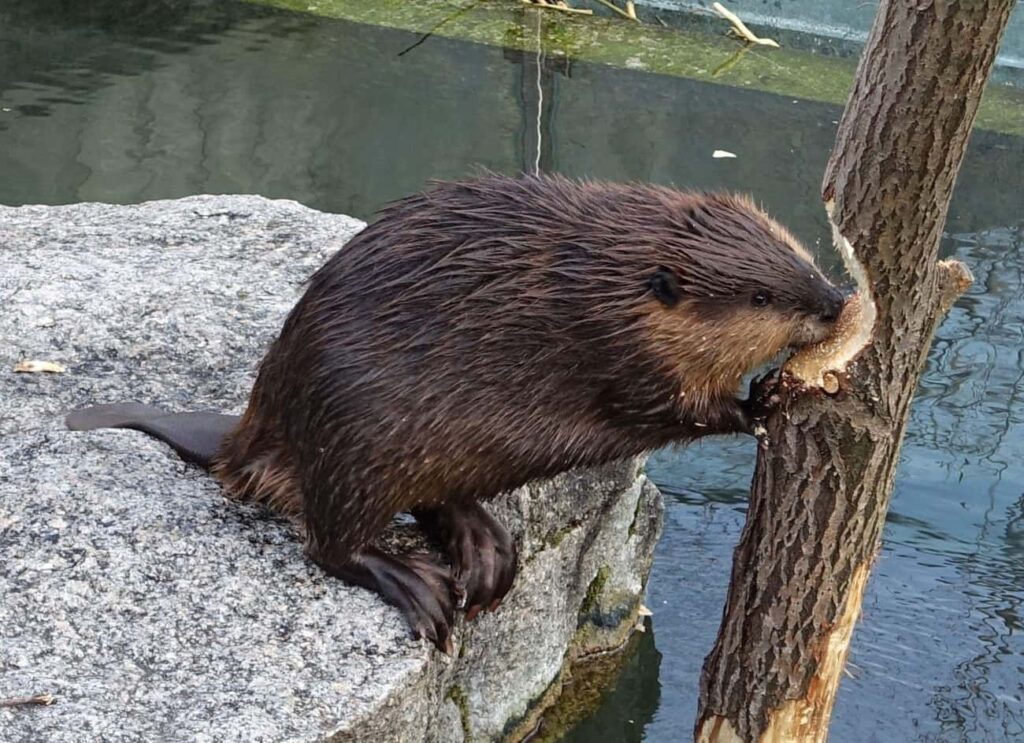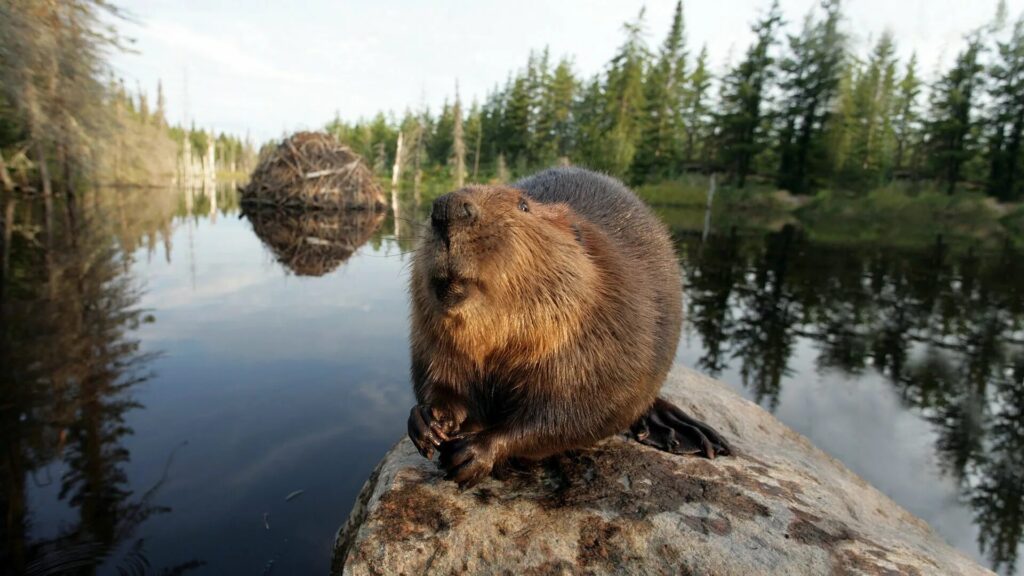Table of Contents
ToggleIntroduction
The extinct giant beaver Castoroides stands as a fascinating testament to the incredible diversity of prehistoric North American megafauna. Extinct Giant Beaver? A colossal rodent that once roamed the continent during the Pleistocene epoch. The giant beaver captured the imaginations of scientists and enthusiasts alike. With its impressive size and distinctive adaptations, this ancient species played a unique role in shaping the landscapes it inhabited. Exploring the story of the extinct giant beaver provides a window into the dynamic ecosystems of the past. Offering insights into the challenges and adaptations that characterized life during this remarkable period of Earth’s history.
Physical Characteristics And Adaptations Of The Extinct Giant Beaver (Castoroides)
Size and Morphology
The extinct giant beaver, scientifically known as Castoroides, was a colossal rodent that inhabited North America during the Pleistocene epoch. This ancient beaver species was notably larger than its modern relatives, reaching sizes that far exceeded contemporary beavers. With an estimated length of up to 8 feet (2.4 meters) and weighing around 220 pounds (100 kilograms), the giant beaver was a formidable presence in the prehistoric landscapes it inhabited. Its size and robust build distinguished it from the smaller, more familiar beavers we encounter today.
Unique Features – Incisors, Tail, and Limbs
The giant beaver possessed distinctive features that set it apart from its modern counterparts. Its most striking characteristic was its oversized incisors, which were markedly larger than those of contemporary beavers. These incisors, continuously growing throughout the giant beaver’s life, were adapted for gnawing through the tough vegetation and woody plants that constituted its diet. The impressive size of these incisors emphasized the species’ specialized adaptation for harvesting and processing vegetation in its Pleistocene environment.
Comparison with Modern Beavers
While the giant beaver shares certain fundamental traits with modern beavers, such as the broad, flat tail and incisors, its sheer size and some anatomical differences highlight its unique adaptations. Modern beavers (Castor canadensis and Castor fiber) are considerably smaller, with an average length ranging from 2 to 3 feet and a weight of around 40 to 60 pounds. Their incisors, though well-developed for cutting through wood and vegetation, are proportionally smaller than those of the giant beaver.
Distribution And Habitat Of The Extinct Giant Beaver (Castoroides)

Geographic Range during the Pleistocene
The extinct giant beaver, Castoroides, once occupied a vast expanse of North America during the Pleistocene epoch, which spanned from approximately 2.6 million to 11,700 years ago. Fossil evidence indicates that the geographic range of the giant beaver extended from present-day Alaska and the Yukon in the west to Florida in the southeast, covering diverse landscapes and ecosystems. This widespread distribution allowed the giant beaver to adapt to various environmental conditions, from the boreal forests of the north to the temperate regions in the south.
Preferred Habitats – Lakes, Rivers, Wetlands
The big beaver liked water and its fossils are usually found near old lakes, rivers, and swamps. This reliance on aquatic environments is consistent with the general behavior of modern beavers. Lakeshores, riverbanks, and wetlands provided the giant beaver with access to the abundant vegetation that constituted its primary diet. The big beaver’s tail and legs were good for swimming and moving in water.
Lakes, in particular, played a crucial role in the giant beaver’s ecology. The availability of aquatic vegetation and the construction of lodges and dams for shelter and protection were likely integral aspects of its lifestyle. The giant beaver’s ability to thrive in such diverse aquatic ecosystems underscores its adaptability and ecological flexibility.
Ecological Niche and Impact on Local Ecosystems
As ecosystem engineers, beavers, including their extinct giant relative, have a significant impact on their surroundings. The giant beaver’s preferred habitats—lakes, rivers, and wetlands—suggest its role in shaping local ecosystems. By constructing dams and lodges, the giant beaver likely influenced water flow, created wetland habitats, and affected vegetation patterns. The alteration of these environments would have had cascading effects on other species, influencing the distribution of plants and animals in the region.
Paleontological Discoveries Of The Extinct Giant Beaver (Castoroides)
Fossil Evidence – Bones, Teeth, and Tracks
Paleontologists have uncovered a wealth of fossil evidence that paints a vivid picture of the extinct giant beaver, Castoroides. Among the most significant findings are the well-preserved bones and teeth that have allowed scientists to reconstruct the anatomy and physiology of this ancient rodent. Fossilized skeletal remains, including skulls, limb bones, and vertebrae, provide insights into the size, structure, and adaptations of the giant beaver.
The incisors, a hallmark feature of beavers, are particularly informative. The size and wear patterns of the giant beaver’s incisors reveal details about its diet and behavior. Tracks from the giant beaver have been discovered. These tracks show how the animal moved and where it lived. These tracks, imprinted in ancient sediments, contribute to our understanding of the giant beaver’s interactions with its environment.
Excavation Sites and Notable Findings
Excavation sites across North America have yielded remarkable discoveries related to the giant beaver. Notable locations include areas around ancient lakes, rivers, and wetlands, where the giant beaver’s affinity for aquatic habitats is evident. Fossils found in many places. Goes from Alaska to eastern US. Shows where extinct species lived.
The Big Bone Lick in Kentucky is an important location. Fossilized remains of the giant beaver and other large animals from the Pleistocene era have been found there. The presence of well-preserved specimens has allowed scientists to conduct detailed analyses, shedding light on the life history, ecology, and interactions of the giant beaver within its ecosystem.
Insights into Giant Beaver Behavior and Lifestyle
Paleontological discoveries have not only revealed the physical attributes of the giant beaver but also provided valuable insights into its behavior and lifestyle. Fossil evidence suggests that the giant beaver built lodges and dams, like modern beavers. The structures were discovered from preserved remains and sediments. They show that the giant beaver was good at changing its environment to meet its needs.
Conclusion
The extinction of the giant beaver marks both the end of an era and a chapter in the ongoing narrative of Earth’s ever-changing ecosystems. The disappearance of this colossal rodent, along with numerous other megafauna, raises questions about the complex interplay of environmental factors and human influence on prehistoric biodiversity. As scientists unravel the mysteries surrounding the giant beaver’s demise, its legacy lives on in the fossils and remnants left behind. The story of the extinct giant beaver serves as a reminder of the impermanence of species and ecosystems, urging us to reflect on our role as stewards of the planet and the ongoing importance of conservation in the face of ecological challenges.







